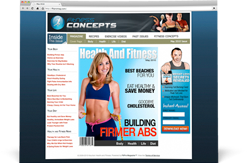The hardest section of your sales funnel is, without a doubt, the transition from prospect to client.
As people move from total stranger to lead to prospect, you know you’re going to lose a lot of them. Your boot camp won’t be right for everyone and that’s OK. And the ones you do get are easy because these stages don’t take much effort or commitment on their part. Essentially, those first stages are all the easy sections of your marketing funnel; it’s the transition from prospect to client that's so difficult.
 It’s not impersonal marketing anymore. It isn't anonymous fire and forget. No, when you’re converting a prospect into a customer it’s all about in-person, face to face interaction.
It’s not impersonal marketing anymore. It isn't anonymous fire and forget. No, when you’re converting a prospect into a customer it’s all about in-person, face to face interaction.
You may have read about this stage of the process before, and that’s because it's complicated. If you want detailed instruction about how to consistently make sales, step by step, there's lots of content out there for you to check out.
But today’s post is a short, detailed list of the four most important tips and ticks to remember when you’re transforming a prospect into a client. Keep these guidelines in mind throughout your entire interaction with your prospect and you’ll have a much easier time converting them into a client.
#1: Guarantee Results
No qualifying, no pussyfooting, and no half-truths. Don’t say they could get results or they might get results or, “it depends on how hard you work.”
No.
You guarantee they will get the results they want. Give them a reasonable timeframe, tell them exactly how their body is going to look and feel, and promise it to them.
Does that make you nervous? Why? Don’t you believe in your services?
(more…)
 The biggest and best names in the Fitness Industry (you know, the guys and girls whose names you always hear floating around the gym or popping up in your Facebook sidebar) are more than just teachers or workout experts. These iconic figures, who spend their time sitting atop the industry’s tallest mountains and making the biggest bucks, are way more than just personal trainers.
The biggest and best names in the Fitness Industry (you know, the guys and girls whose names you always hear floating around the gym or popping up in your Facebook sidebar) are more than just teachers or workout experts. These iconic figures, who spend their time sitting atop the industry’s tallest mountains and making the biggest bucks, are way more than just personal trainers.
Ever wondered how they reached such lofty heights? Sure, it has a lot to do with work ethic and personal situations and maybe a bit of luck, but there is one tool, one strategy that each of these giants uses to reach the tip-top of the Fitness Industry leaderboards.
Want to know what it is?
It’s storytelling.
Or, said differently, StorySelling.
Each of these greats has mastered the art of leveraging his or her personal origins and anecdotes to establish professional ethos (reputation) and, more importantly, make money from it.
O.K., let’s backtrack a little here and take a look at some examples.
Take, for instance, Jason Ferruggia. Jason is obviously an incredibly talented and knowledgeable teacher, author, and fitness expert. There is no doubt that his mastery and expertise are the driving forces contributing to his success. But there are certain tricks, strategies, and nuances that he uses to transform him from personal trainer to fitness celebrity.
Everyone knows Ferruggia for his incredible blog and his awesome products. He’s huge because he produces great content, but he’s a celebrity because people like, adore, and emulate him: his personality, his image, his story.
When you hear “Jason Ferruggia,” what sorts of thoughts and images immediately jump into your mind? Is it “Muscle Gaining Secrets?” Maybe you think of “The Renegate Diet?” Or, do you think hard ass, no B.S., straight shooting and hard-hitting writer, blogger, and fitness personality?
Thought so.
You see, Ferruggia doesn’t just have the awesome content and top-notch talent, he has created an image of himself that builds rapport, gains customer trust, and sells product through generating fascination and fandom within his audience.
Let’s take a look at a more understated example.
(more…)
In my last blog post, I explained how selling personal training through an online program can bring you long term passive income as well as new clients for your fitness boot camp business. To recap what I explained in the last post, there are several benefits to offering personal training through an online coaching program:
- Immediate income generated through sales.
- Long-term income potential through building trust and credibility.
- Passive income from your program with no significant work needed from you.
- Potential new client income through program’s visibility on Facebook and other social media.
- Potential new long-term clients by converting online members to boot camp members.
But first you need to decide what type of program you’re going to create and then how to set up the marketing and delivery for that program. Fortunately, Shawna Kaminski, the FBBC owner who earned $7,000 in 72 hours with her online coaching program, was kind enough to offer up a blueprint for both.
Creating Your Online Coaching Program
 Selling personal training through an online coaching program isn’t that much different from coaching clients in your boot camp. Think about what you provide your clients in your boot camp in order to get them the results they need: nutritional guidance, a great workout, accountability, motivation and support from both you and fellow clients. These are the things that need to be included in your online coaching program. You can even create a partnership with a local nutritionist. They can create the nutrition plan, you create the workouts and both of you market to each other’s mailing lists.
Selling personal training through an online coaching program isn’t that much different from coaching clients in your boot camp. Think about what you provide your clients in your boot camp in order to get them the results they need: nutritional guidance, a great workout, accountability, motivation and support from both you and fellow clients. These are the things that need to be included in your online coaching program. You can even create a partnership with a local nutritionist. They can create the nutrition plan, you create the workouts and both of you market to each other’s mailing lists.
The type of nutritional plan and workout that you create for the program will depend on your expertise, your group’s goal and their demographic. It will depend on whether you’re doing a fat-burning program, a strength building program, a special abs program and so on. You could also skip the specialization altogether and make your selling point the fact that people who aren’t ready/comfortable with/into a group training environment can get all of the benefits of your boot camp right in their own home.
Prior to creating her online coaching program, Shawna polled her mailing list and got their basic information and also asked them what their specific fitness issues and obstacles were. Then she took that information and created a program that would meet the needs of the most people.
Structuring Your Online Coaching Program
It’s important to keep things as simple and consistent as possible, especially your first time around. Shawna set up a 90 day coaching plan, which she priced at $99/month, paid up front at $297. She changed up the workouts every few weeks and a created a scalable nutrition plan. She met with her coaching clients daily in a private group on Facebook to provide that accountability, motivation and support that people need to succeed. (more…)
Fitness boot camp owners have to be experts at balancing time and money. They have to know when it’s better to spend money and save time or vice versa. They also have to know how to maximize their income for the hours they spend running their business. The Fit Body Boot Camp business model is based on the principle of maximum earnings for minimum labor. The boot camp model was created because group training earns much more per hour than selling personal training one-on-one.
But you can take the principle of maximum earnings for minimum time one step further, by creating streams of income that earn you passive income long after the work has been done. Two of the best ways to do this are by creating and selling fitness info products and by offering online coaching.
 Online coaching can be a huge moneymaker for you. It was for FBBC superstar Shawna Kaminski, who just brought in $7,000 in 72 hours with her first online coaching program. The beauty of it is that you usually have to do very little once you’ve created the programs you’re offering clients.
Online coaching can be a huge moneymaker for you. It was for FBBC superstar Shawna Kaminski, who just brought in $7,000 in 72 hours with her first online coaching program. The beauty of it is that you usually have to do very little once you’ve created the programs you’re offering clients.
Most of the time, you create a program or set of programs, set up a payment and delivery system, create a marketing campaign and then have something that can continue to earn money for you, while all you might do is tweak your marketing or start a new marketing campaign periodically.
Fitness info products and online coaching share some similarities and can achieve the same results, but they have some important differences. You might create a workout and nutrition program focused on losing belly fat and package it into a fitness info product, or you could create the same program and offer it via online coaching. The main differences between the two are price and interaction. (more…)
 It’s not impersonal marketing anymore. It isn't anonymous fire and forget. No, when you’re converting a prospect into a customer it’s all about in-person, face to face interaction.
It’s not impersonal marketing anymore. It isn't anonymous fire and forget. No, when you’re converting a prospect into a customer it’s all about in-person, face to face interaction. The biggest and best names in the Fitness Industry (you know, the guys and girls whose names you always hear floating around the gym or popping up in your Facebook sidebar) are more than just teachers or workout experts. These iconic figures, who spend their time sitting atop the industry’s tallest mountains and making the biggest bucks, are way more than just personal trainers.
The biggest and best names in the Fitness Industry (you know, the guys and girls whose names you always hear floating around the gym or popping up in your Facebook sidebar) are more than just teachers or workout experts. These iconic figures, who spend their time sitting atop the industry’s tallest mountains and making the biggest bucks, are way more than just personal trainers. Selling personal training through an online coaching program isn’t that much different from coaching clients in your boot camp. Think about what you provide your clients in your boot camp in order to get them the results they need: nutritional guidance, a great workout, accountability, motivation and support from both you and fellow clients. These are the things that need to be included in your online coaching program. You can even create a partnership with a local nutritionist. They can create the nutrition plan, you create the workouts and
Selling personal training through an online coaching program isn’t that much different from coaching clients in your boot camp. Think about what you provide your clients in your boot camp in order to get them the results they need: nutritional guidance, a great workout, accountability, motivation and support from both you and fellow clients. These are the things that need to be included in your online coaching program. You can even create a partnership with a local nutritionist. They can create the nutrition plan, you create the workouts and  Online coaching can be a huge moneymaker for you. It was for FBBC superstar Shawna Kaminski, who just
Online coaching can be a huge moneymaker for you. It was for FBBC superstar Shawna Kaminski, who just 
